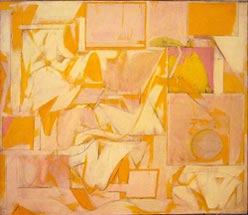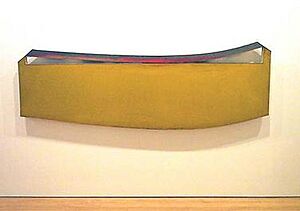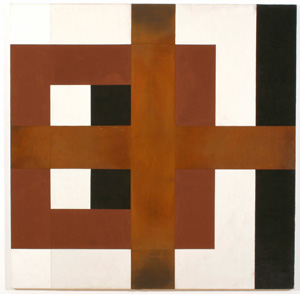Harvey Quaytman facts for kids
Quick facts for kids
Harvey Quaytman
|
|
|---|---|

Riley Mumbling to Himself at Night (1961-63)
|
|
| Born | April 20, 1937 |
| Died | April 8, 2002 (aged 64) |
| Nationality | American |
| Education | Boston Museum School |
| Movement | Abstract art |
| Awards | Guggenheim Fellowship, Elizabeth Foundation Prize for Painting, American Academy of Arts and Letters - Academy Award in Art, National Endowment for the Arts fellowship |
Harvey Quaytman (born April 20, 1937 – died April 8, 2002) was an American painter. He was famous for his large, colorful abstract paintings. His art often featured strong, single colors and clear, sharp lines. He was inspired by famous artists like Kazimir Malevich and Piet Mondrian. Harvey Quaytman had over 60 art shows during his life. His paintings are now in many important museums around the world.
Contents
Early Life and Family
Harvey Quaytman was born in Far Rockaway, Queens, New York. This was on April 20, 1937. His father, Marcus, was from Lodz, Poland. His mother, Rose, taught piano. When Harvey was young, his father and grandfather died in a train accident.
He went to Syracuse University from 1955 to 1957. He later graduated in 1959 from Tufts University and the School of the Museum of Fine Arts, Boston. There, he met and married Susan Howe, who became a famous poet. In 1961, they had a daughter named Rebecca. Rebecca also grew up to be a well-known abstract painter.
In 1963, the family moved to Soho, New York City. Harvey Quaytman married two more times during his life. His third wife was Margaret Moorman, a writer. They had a daughter named Emma.
Harvey Quaytman died in New York on April 8, 2002. He passed away from cancer.
Awards and Recognitions
Harvey Quaytman received many awards for his art. In 1972 and 1975, he won a CAPS Grant. This grant helps artists with their work. He also received a Guggenheim Fellowship in 1979 and 1985. This is a special award given to people who have shown great ability in their fields.
In 1983, he got an Artist’s Fellowship from the National Endowment for the Arts. By 1993, he became a member of the National Academy of Design. This is a group of important American artists. In 1994, he won the Elizabeth Foundation Prize for Painting. Finally, in 1997, he received the Academy Award in Art. This award came from the American Academy of Arts and Letters.
His Artistic Style and Works
Harvey Quaytman was known for his unique style. He continued to explore geometric abstraction and modernist art. These art styles use shapes, lines, and colors to create feelings or ideas. Even though some thought these styles were fully explored, he kept finding new ways to make them exciting. Critics said his art became bolder and more creative over time.
In the late 1960s and 1970s, his paintings stood out. He often used "shaped canvases." This means the canvas itself was not a simple rectangle. It might be curved or have unusual edges. His paintings often mixed ideas from abstract expressionism and geometric art. Over time, his work became more focused on clear geometric shapes.
By the 1980s, he returned to using regular rectangular and square canvases. He also started using the "cruciform" (cross) shape a lot. This cross shape became a main focus for his art in the next ten years.
In the 1990s, he stopped using curved shapes. He focused mostly on the cross shape. Sometimes the canvas itself was shaped like a cross. Other times, the cross was painted onto the canvas. He often mixed rust and acrylic paint. He also used glass in his art. This created many different textures in his paintings. After 1998, he was too ill to work.
Exhibitions and Collections
After Harvey Quaytman passed away, his art gallery, McKee Gallery, held a special show. It was called "Harvey Quaytman: A Survey of Paintings and Drawings 1969-1998." A "survey" or "retrospective" is a show that looks back at an artist's work over many years.
Other important shows of his work were held later. In 2005, McKee Gallery had "Flying the Colors." This show celebrated his bold use of color. In 2011, another show, "A Sensuous Geometry," focused on his later works. In 2018, the Berkeley Art Museum and Pacific Film Archive also held a large show of his art.
Today, you can see Harvey Quaytman's paintings in many public museums. Some of these include:
- Museum of Modern Art
- Whitney Museum of American Art
- Museum of Fine Arts, Boston
- Minneapolis Institute of Art
- Corcoran Gallery of Art
- Carnegie Museum of Art
- Neuberger Museum of Art
His remaining artworks are represented by McKee Gallery in New York, Blum & Poe in Los Angeles, and Nielson Gallery in Boston.



